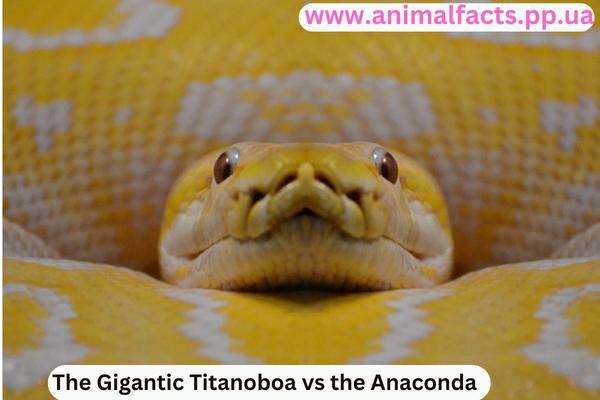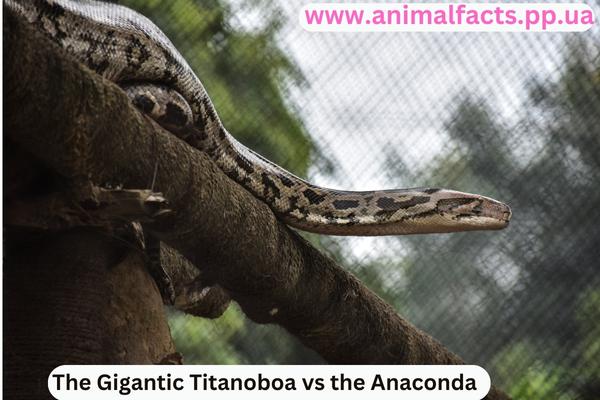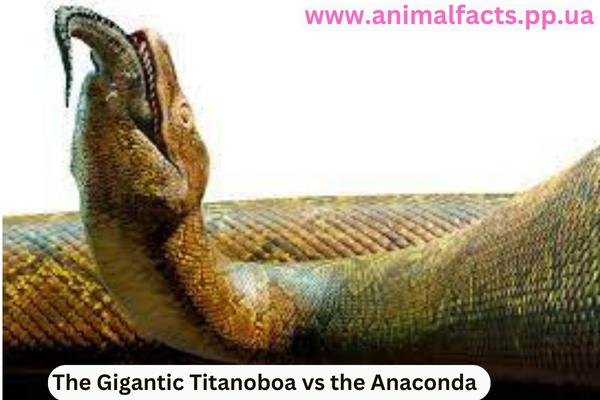The Gigantic Titanoboa vs the Anaconda
Introduction
Throughout history, the Earth has been home to some genuinely colossal snakes, inspiring awe and fascination among scientists and the general public.
Among these giants, the Titanoboa and the Anaconda are the largest snakes ever recorded. In this article, we will delve into the world of these incredible creatures, exploring their sizes, habitats, and notable characteristics.
Join us as we compare the dimensions of the Gigantic Titanoboa and the Anaconda, shedding light on the awe-inspiring scale of these ancient and modern serpents.
1. The Gigantic Titanoboa
The Titanoboa, a prehistoric snake that roamed the Earth approximately 58-60 million years ago during the Paleocene epoch, holds the title of the most giant snake ever discovered.
Fossils found in South America indicate that this enormous reptile could reach astounding lengths of up to 42 feet (12.8 meters) and weigh around 2,500 pounds (1,134 kilograms). Its massive size surpasses that of any snake known to have existed.
2. The Anaconda
In the present day, the Anaconda takes the crown as the largest snake species. Found in the tropical rainforests and swamps of South America, the Anaconda comes in various subspecies,
with the Green Anaconda (Eunectes murinus) being the largest. Although not as colossal as the Titanoboa, the Anaconda is still an impressive creature.
It can grow to lengths of around 17-20 feet (5-6 meters) and weigh up to 550 pounds (250 kilograms), making it one of the heaviest snakes alive today.
3. Size Comparison
When comparing the Titanoboa and the Anaconda, it becomes evident that the Titanoboa reigns supreme in terms of sheer size. The Titanoboa’s length is more than double that of the Anaconda, and its weight surpasses it by a considerable margin.
However, it is essential to note that the Titanoboa existed during a different geological era when the environment and available prey were different from those of today. The Anaconda, as the largest living snake, is still an impressive creature in its own right.
4. Physical Features and Adaptations
Both the Titanoboa and the Anaconda possess unique physical features and adaptations that enable them to thrive in their respective environments. The Titanoboa’s massive size allowed it to overpower and consume large prey,
such as crocodiles, with relative ease. Its elongated body and powerful muscles provided the strength and flexibility necessary for such feats. On the other hand,
the Anaconda relies on its muscular body and strong jaws to capture and constrict its prey, primarily consisting of aquatic animals like fish, turtles, and caimans.
5. Ecological Roles

The Titanoboa and the Anaconda play significant ecological roles within their habitats. The Titanoboa, as a top predator during its time, would have influenced the population dynamics of its environment.
Its presence would have affected prey species and potentially shaped the evolution of other organisms. In contrast, the Anaconda serves as an apex predator in the Amazon rainforest, regulating prey populations and contributing to the balance of the ecosystem.
6. Conservation Status and Human Interactions
While the Titanoboa is an extinct species and no longer faces conservation concerns, the Anaconda’s populations are currently stable. However, habitat loss, pollution, and hunting threaten the Anaconda’s long-term survival.
These snakes are often misunderstood and, unfortunately, sometimes targeted due to unfounded fears. Humans must respect and protect these remarkable creatures to ensure their continued existence.
7. Behavioural Contrasts
Apart from their size differences, the Titanoboa and the Anaconda also exhibit contrasting behaviours. As a cold-blooded reptile, the Titanoboa likely relied on external heat sources to regulate its body temperature.
It may have spent much of its time basking in the sun or near warm water bodies. In contrast, the Anaconda is a primarily aquatic snake, spending much of its life in or near water.
It is an excellent swimmer, using its muscular body and flattened tail to navigate rivers, swamps, and flooded forests.
8. Reproduction and Life Cycle
Little is known about the reproductive behaviour of the Titanoboa due to the limited fossil evidence available. However, it is believed to have laid eggs, similar to modern-day constrictor snakes like the Anaconda.
Female Anacondas are known for their unique reproductive strategy known as ovoviviparity, where they retain and incubate their eggs internally until they give birth to live young.
This adaptation allows the Anaconda to give birth to fully developed offspring, giving them a higher chance of survival.
9. Influence on Popular Culture
The immense size and reputation of the Titanoboa and the Anaconda have made them popular subjects in literature, films, and documentaries. The discovery of the Titanoboa fossils in 2009 created a global sensation, leading to numerous scientific studies and media coverage.
The Anaconda, with its powerful constricting abilities and impressive size, has been featured prominently in movies like “Anaconda” (1997) and has become a symbol of fear and fascination in popular culture.
10. Fascination with Giant Snakes
The allure of giant snakes extends beyond their physical dimensions. These creatures captivate our imagination and spark curiosity about the natural world.
They inspire awe and wonder, pushing the boundaries of what we consider possible regarding size and adaptation. By studying these snakes, we gain insights into the ancient ecosystems they inhabited and the evolutionary forces that shaped their existence.

Snakes remain some of the most fascinating creatures in the animal kingdom due to their mystery and ability to adapt. While anacondas are famous today for their immense proportions,
prehistoric times brought an even greater giant – Titanoboa. Let’s explore the jaw-dropping size differences between these two snakes that truly redefined colossal.
Titanoboa – The True Goliath
Fossil evidence uncovered in Colombia revealed a snake species from the Paleocene era dwarfing all others – Titanoboa cerrejonensis. Estimated at a monstrous 48-60 feet long and 1,135-1,650 pounds, this snake made present-day anacondas appear petite.
Titanoboa’s massive coil could engulf large crocodilians and even small horses with its disproportionately wide body and neck. It ruled rivers 60 million years ago before disappearing, leaving its record unchallenged until modern times.
Green Anaconda – Today’s Heavyweight Champion
As the largest extant snake, green anacondas weigh around 29 feet and often weigh over 550 pounds. Despite their reputation for strength, anacondas fail to compete with Titanoboa’s truly enormous dimensions.
A grown green anaconda would easily fit inside the coiled body of a single Titanoboa vertebrae fossil. Touching the upper boundary of 30 feet, an anaconda and Titanoboa skull placed together illustrates the latter’s jaw was over 3 times as long.
Scale Tells the Tale
There’s no comparison between Titanoboa’s magnitude dwarfing all later snakes and the impressive yet markedly smaller anaconda.
One wrap from the prehistoric behemoth would have engulfed multiple adult humans, making its mythical status as the undisputed heavyweight champion of Serpentes well deserved after 60 million years since it dominated the planet.
Perspective on animal size leaves anacondas looking modest while gasping in awe of Titanoboa’s formidable prehistoric supremacy.
Titanoboa vs anaconda size comparisons

- Break down the size ratio between Titanoboa and Anaconda. For example, a large anaconda would have fit inside the mouth of Titanoboa.
- Describe the unique physical attributes that allowed Titanoboa to achieve such an immense size, such as its climate/environment, a diet high in nutrients, etc. This provides context for its colossal proportions.
- Discuss the hunting/feeding strategies that were possible due to Titanoboa’s gigantic size. It could have constricted massive prey animals, unlike any modern snake.
- Contrast key anatomical differences like bone structure and musculature that supported Titanoboa’s tremendous girth versus a more slender anaconda design.
- Speculate on what ecosystem pressures or changes may have contributed to Titanoboa eventually going extinct while anacondas still exist today at a smaller size.
- Consider the importance of fossils in reconstructing lost beasts like Titanoboa to appreciate the full spectrum of snake evolution and prior dominance of giant species.
- Provide a visual size comparison chart or illustration comparing the length and girth of a reconstructed Titanoboa with an adult anaconda for perspective.
- Reference any famously giant snakes from history or lore to further showcase Titanoboa’s status as the unambiguous heavyweight of all serpents.
Conclusion
The Titanoboa and the Anaconda represent two remarkable examples of snakes that have captivated human fascination throughout history.
While the Titanoboa is an extinct giant that dominated the prehistoric world, the Anaconda is the most giant living snake today.
Their contrasting sizes, behaviours, and adaptations highlight the diversity and complexity of snakes as a group. As we continue to explore and learn about these magnificent creatures, we deepen our understanding of the natural world and our place within it.


